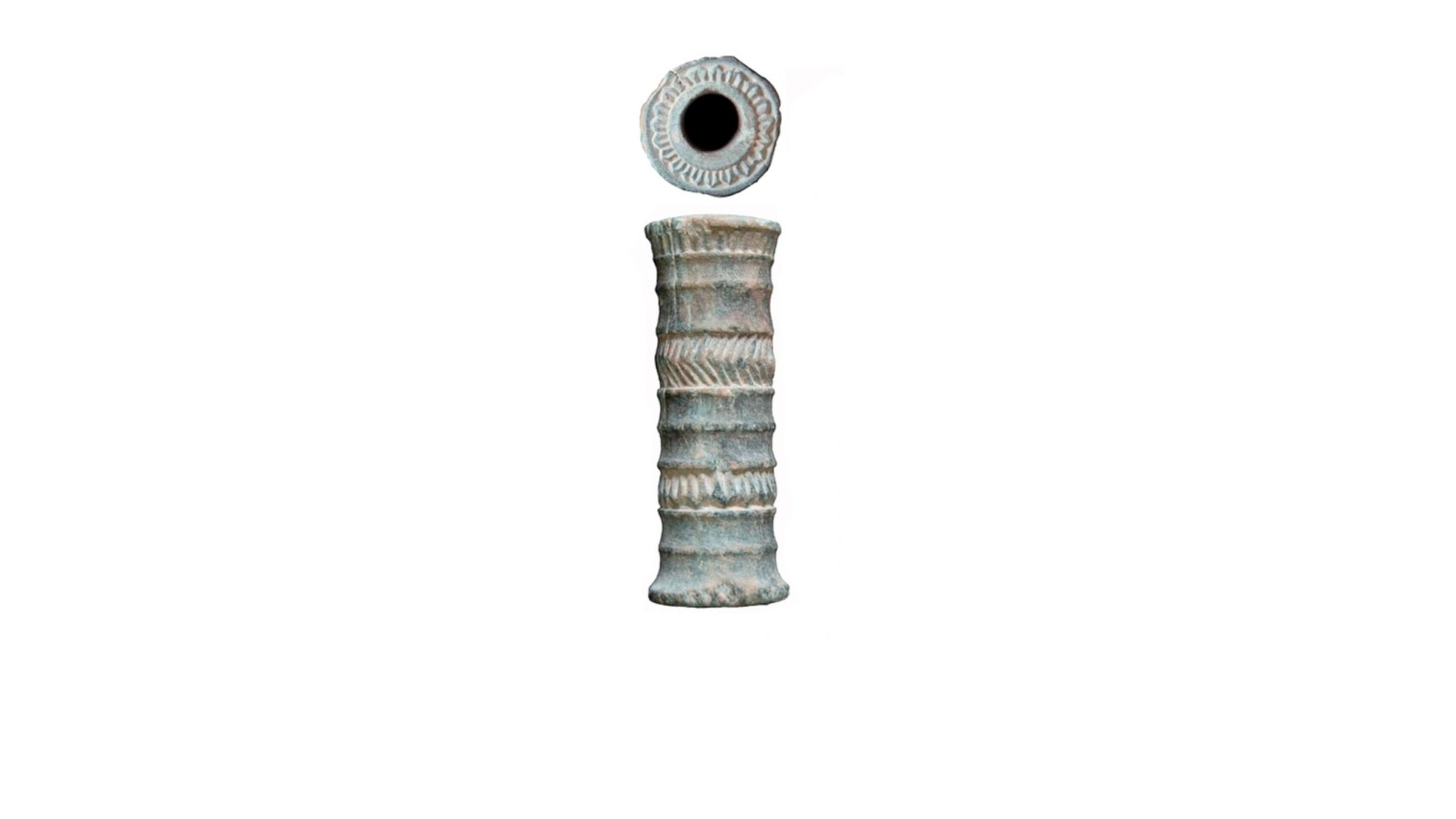While makeup trends have evolved over the last 4,000 years, a recent study apparently proves that the age-old saying is true: the beauty of a red lip is timeless.
Researchers have identified what is believed to be the world’s oldest known lipstick, or lip paint – a small, ornate stone vial containing a deep red paste, which was discovered in southeastern Iran.
“We hypothesize a lip paint, rather than a solid lipstick because we have no certain idea about the original consistency or fluidity of the cosmetic substance,” Massimo Vidale, one of the study’s lead researchers and a professor of archaeology at the University of Padua in Italy, told ABC News in a statement.
The Bronze Age artifact is carbon dated to between 1936 B.C. and 1687 B.C. and was originally discovered in 2001, when a flood unearthed ancient graveyards, according to a study published in February in the journal Scientific Reports.

The carved chlorite vial containing the cosmetic preparation.
University of Padova and ISMEO, Rome
The 2001 flooding of the Halil River Valley, 25 miles south of Jiroft, Iran, exhumed ancient ruins from what is believed to be the Bronze Age Marḫaši civilization, a “powerful” people who are believed to have thrived alongside Mesopotamia, according to the study.
Researchers said the ancient lipstick vial, as well as jewelry, weapons, and finely crafted ceramics were among the artifacts looted from the ruins and sold to antique markets before being recovered by Iranian officials.
“A small chlorite vial, discovered among numerous artifacts looted and recovered in the Jiroft region of Kerman province contains a deep red cosmetic preparation that is likely a lip-coloring paint or paste,” researchers said in the study.
The vial was included in a collection at the Jiroft Archaeological Museum in Iran before it was analyzed by researchers from the Italian University of Padua, Iranian University of Tehran, and the International Association for Mediterranean and Oriental Studies in Rome.
The hand-carved stone vial is approximately two inches tall by three-quarters of an inch wide, which is slightly smaller than modern-day lipsticks, according to the study.

Mineralogical composition of the cosmetic preparation. Enhanced in false colors, red, micro-stratified fragmented sheets of hematite pinacoid forms; pseudo-octahedral crystals of braunite in yellow; fragmented (ground) quartz particles in pink. Rare cubic crystals of galena appear in green.
University of Padova and ISMEO, Rome
One of the most notable findings in the study is that the mineral components of the lipstick artifact “[bear] a striking resemblance to the recipes of contemporary lipsticks,” researchers said.
The ingredients identified by a scanning electron microscope include hematite, darkened with manganite and braunite, and traces of galena and anglesite, mixed with vegetal waxes and other organic substances, according to Vidale, who further noted, “combined it is exactly what one would expect in a modern lipstick.”
For Vidale, the discovery draws a close connection between women of an ancient civilization to those of today.
“I’ve always felt closely connected to the people and civilizations of ancient Iran,” Vidale said. “And having a grown-up daughter, I’ve always been deeply intrigued when I came across material evidence that could be linked to women and children of that age and those cultures.”
A recent study has revealed that ancient lipstick found in Iran is believed to be the oldest in the world, dating back an astonishing 4,000 years. This discovery sheds new light on the ancient beauty practices of the people living in the region during that time period.
The lipstick was discovered during an archaeological excavation in the ancient city of Susa, located in present-day Iran. The researchers found a small, cylindrical container made of black stone that contained traces of a red pigment. Upon further analysis, it was determined that the pigment was made from a combination of crushed gemstones and minerals, mixed with animal fat to create a smooth paste.
This finding is significant because it provides insight into the beauty rituals of ancient civilizations. The use of lipstick for cosmetic purposes dates back thousands of years, with evidence of its use found in various cultures around the world. However, this discovery in Iran is particularly noteworthy due to its age and the sophisticated methods used to create the lipstick.
The researchers believe that the ancient Iranians used the lipstick not only for cosmetic purposes but also for religious and ceremonial reasons. The vibrant red color was likely seen as a symbol of power and status, and may have been used in rituals to honor deities or mark important occasions.
In addition to its cultural significance, the discovery of the ancient lipstick also provides valuable information about the technological advancements of the time. The fact that the lipstick was made from a combination of crushed gemstones and minerals shows that the ancient Iranians had a sophisticated understanding of chemistry and materials science.
Overall, this study reveals a fascinating glimpse into the beauty practices of ancient civilizations and highlights the importance of cosmetics in human history. The discovery of the oldest lipstick in the world in Iran is a testament to the enduring appeal of beauty rituals and serves as a reminder of the timeless desire to enhance one’s appearance.



